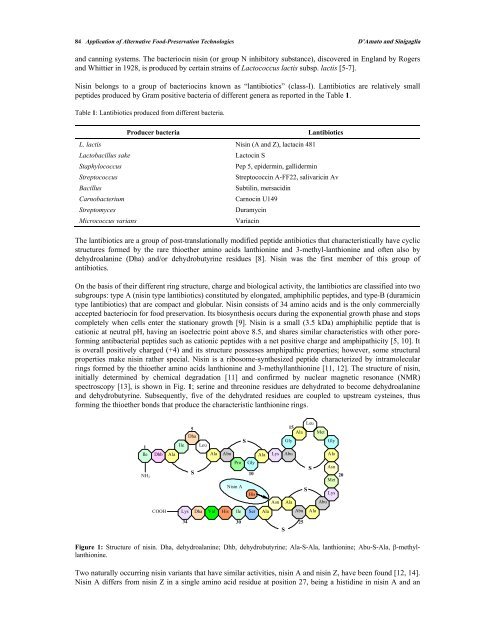application of alternative food-preservation - Bentham Science
application of alternative food-preservation - Bentham Science
application of alternative food-preservation - Bentham Science
Create successful ePaper yourself
Turn your PDF publications into a flip-book with our unique Google optimized e-Paper software.
84 Application <strong>of</strong> Alternative Food-Preservation Technologies D’Amato and Sinigaglia<br />
and canning systems. The bacteriocin nisin (or group N inhibitory substance), discovered in England by Rogers<br />
and Whittier in 1928, is produced by certain strains <strong>of</strong> Lactococcus lactis subsp. lactis [5-7].<br />
Nisin belongs to a group <strong>of</strong> bacteriocins known as “lantibiotics” (class-I). Lantibiotics are relatively small<br />
peptides produced by Gram positive bacteria <strong>of</strong> different genera as reported in the Table 1.<br />
Table 1: Lantibiotics produced from different bacteria.<br />
Producer bacteria Lantibiotics<br />
L. lactis Nisin (A and Z), lactacin 481<br />
Lactobacillus sake Lactocin S<br />
Staphylococcus Pep 5, epidermin, gallidermin<br />
Streptococcus Streptococcin A-FF22, salivaricin Av<br />
Bacillus Subtilin, mersacidin<br />
Carnobacterium Carnocin U149<br />
Streptomyces Duramycin<br />
Micrococcus varians Variacin<br />
The lantibiotics are a group <strong>of</strong> post-translationally modified peptide antibiotics that characteristically have cyclic<br />
structures formed by the rare thioether amino acids lanthionine and 3-methyl-lanthionine and <strong>of</strong>ten also by<br />
dehydroalanine (Dha) and/or dehydrobutyrine residues [8]. Nisin was the first member <strong>of</strong> this group <strong>of</strong><br />
antibiotics.<br />
On the basis <strong>of</strong> their different ring structure, charge and biological activity, the lantibiotics are classified into two<br />
subgroups: type A (nisin type lantibiotics) constituted by elongated, amphiphilic peptides, and type-B (duramicin<br />
type lantibiotics) that are compact and globular. Nisin consists <strong>of</strong> 34 amino acids and is the only commercially<br />
accepted bacteriocin for <strong>food</strong> <strong>preservation</strong>. Its biosynthesis occurs during the exponential growth phase and stops<br />
completely when cells enter the stationary growth [9]. Nisin is a small (3.5 kDa) amphiphilic peptide that is<br />
cationic at neutral pH, having an isoelectric point above 8.5, and shares similar characteristics with other poreforming<br />
antibacterial peptides such as cationic peptides with a net positive charge and amphipathicity [5, 10]. It<br />
is overall positively charged (+4) and its structure possesses amphipathic properties; however, some structural<br />
properties make nisin rather special. Nisin is a ribosome-synthesized peptide characterized by intramolecular<br />
rings formed by the thioether amino acids lanthionine and 3-methyllanthionine [11, 12]. The structure <strong>of</strong> nisin,<br />
initially determined by chemical degradation [11] and confirmed by nuclear magnetic resonance (NMR)<br />
spectroscopy [13], is shown in Fig. 1; serine and threonine residues are dehydrated to become dehydroalanine<br />
and dehydrobutyrine. Subsequently, five <strong>of</strong> the dehydrated residues are coupled to upstream cysteines, thus<br />
forming the thioether bonds that produce the characteristic lanthionine rings.<br />
1<br />
Ile<br />
NH2<br />
Dhb<br />
COOH<br />
Ala<br />
Ile<br />
5<br />
Dha<br />
S<br />
Leu<br />
Ala<br />
Abu<br />
Pro<br />
Nisin A<br />
Lys Dha Val His Ile<br />
34<br />
30<br />
S<br />
Ala Lys Abu<br />
Ala<br />
Gly<br />
S Asn<br />
10<br />
20<br />
Met<br />
His<br />
S<br />
Lys<br />
Asn Ala<br />
Abu<br />
Ser Ala<br />
Abu Ala<br />
Figure 1: Structure <strong>of</strong> nisin. Dha, dehydroalanine; Dhb, dehydrobutyrine; Ala-S-Ala, lanthionine; Abu-S-Ala, β-methyllanthionine.<br />
Two naturally occurring nisin variants that have similar activities, nisin A and nisin Z, have been found [12, 14].<br />
Nisin A differs from nisin Z in a single amino acid residue at position 27, being a histidine in nisin A and an<br />
S<br />
Leu<br />
15<br />
Ala Met<br />
Gly<br />
25<br />
Gly

















